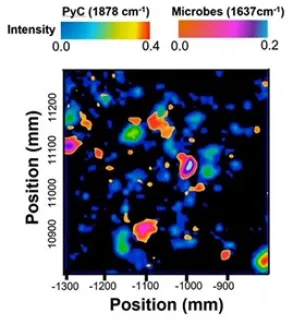Synchrotron radiation-based Fourier transform infrared spectral imaging shines light to microbial metabolism and soil chemistry of Arctic permafrost.
The fate of Arctic carbon depends on the complex relationship between microbial communities, carbon stocks, and changes in temperature regimes, as well as how these factors interact during thaw to emit greenhouse gases. To assess the contribution of each component, measurements at relevant scales are needed. Our current understanding of the change in organic matter chemistry in Arctic soils is based on bulk measurements in the scale of gram material (millimeters to centimeters) that cannot account for -scale spatial differences with significant surface topography that are critical for understanding microbial interactions and transformations. The Berkeley Synchrotron Infrared Structural Biology (BSISB) imaging program, located at Lawrence Berkeley National Laboratory’s Advanced Light Source, develops and provides infrared imaging methodologies to look at molecular structure and chemical bonds. Neslihan Taş and her team analyzed soil and permafrost samples, including those collected from NGEE Arctic field site in Barrow Environmental Observatory, using synchrotron radiation-based Fourier transform infrared spectral imaging (SR-FTIR) at the BSISB beamline. The team nondestructively observed microbes within soil samples, examined their intracellular and extracellular chemistry, and analyzed the chemical signatures of the bonds. The SR-FTIR system gives different vibrations of the bonds that can be decoded to determine related compounds, such as the signature for organic material, minerals, and bacteria. The Lawrence Berkeley National Laboratory team has used the combination of SR-FTIR, DNA (metagenomics), and RNA (metatransciptomics) sequencing to begin quantifying the impacts to microbial metabolism of environmental drivers, such as ice content, topography, continuity, active layer depth, and vegetation in the Arctic. Omics techniques reveal shifting microbial presence and function, and the importance of interactions between microbes that carry out Fe, sulfur, and carbon metabolism. SR-FTIR reveals changes in soil chemistry, especially where microbes reside. Together, the techniques enable in-depth functional characterization of microbial metabolism in permafrost to understand microbial responses to thaw and how it may contribute to greenhouse gas emissions
SR-FTIR imaging maps microbial distribution and identifies chemical functional groups of biological molecules. The infrared imaging technique coupled with autonomous artificial intelligence can be used to scan soil samples looking for markers and signatures related to a particular science question.
For more information, please contact:
Neslihan Taş
ntas@lbl.gov

